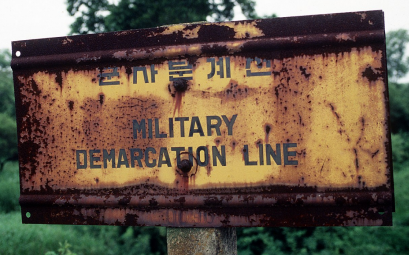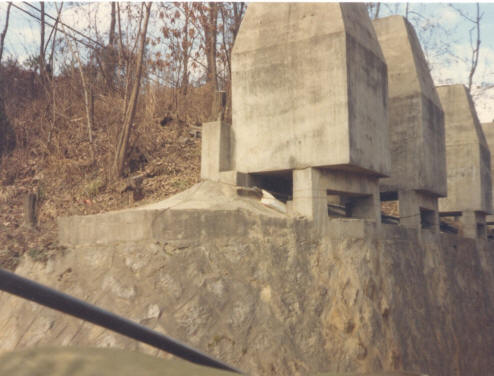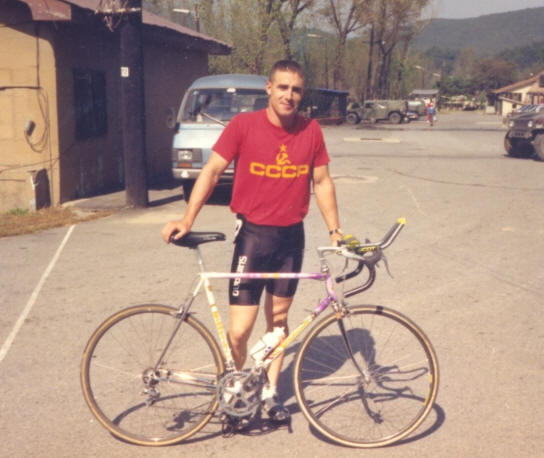Minefield marking, South Korean sector of Demilitarized Zone. (DOD)
Minefield marking, South Korean sector of Demilitarized Zone.
(DOD)
OH SHIT, I’M FUCKED!!
The waterbottle that tried to kill me
August 1990 The Korean Demilitarized Zone (DMZ)
My first Army assignment, after a year of initial training, was to 5-20 Infantry
(Mechanized) in Korea. I had done a lot of cycling in college and missed it very
much. So when the bitterly cold winter relented, I mail-ordered from a US-based
bike shop an exotic
Italian bike, similar to the ones I’d long admired in cycling magazines.
Cycling in the UN area of the DeMiliterized Zone (DMZ) that separates the two Koreas.
The Korean DMZ is a 4km wide swath that separates North and South Korea. The actual lines that runs down the center of that swath is called the Military Demarcation Line and is marked by an occasional rusty yellow sign covered in bushes. If you’re wandering around your side of the DMZ and you’re not careful, you can end up in a country where people don’t like you. The UN sector of the DMZ is just a small portion that includes the Panmunjom peace village, which is two lies in one. Neither a village nor peaceful. The rest of the friendly side of the DMZ is patrolled by South Korea.

The MDL marks the line between the enemy minefields that kill you and the friendly minefields that will kill you. (DOD)
The Korean DMZ is a war zone. The Koreas agreed to quit shooting at each other in 1953, but never signed a peace treaty. In fact, North Korea routinely shoots at people across the border and occasionally sends armed insurgents to cause mischief. The NKPA, North Korean People's Army, is the fourth largest such in the world.

Graphic of Korean DMZ showing the swath across the peninsula and
the Military Demarcation Line (MDL) that separates the two, 2km deep, swaths.
Each country has heavily mined their zone and patrols aggressively.
I was stationed on the Korean DMZ for four months. The war zone turned out to be a terrific area for cycling. I had Sunday mornings off so I would go for a ride. The roads were in good shape and there was little traffic. The only limitation was that I couldn't leave the DMZ and head deeper into South Korea because that would have meant crossing the Imjin River. The bridge had an American checkpoint and their sense of humor was unreliable. In contrast, if I stayed in the DMZ by riding into the adjacent South Korean patrolled sectors, the Korean soldiers at those checkpoints thought the sudden appearance of an American cyclist was hilarious, and they'd wave and smile as I rode by.
Cycling in the UN and South Korean sections of the DMZ. Note
the HMMWV in the background. In order to get this picture I rode hard to catch
up to some HMMWV and handed them my camera. Since I had no jersey on that day, I
had no pockets. What prompted me to ride that day with a camera shoved down my
shorts, went unrecorded. Summer, 1990.
I knew better than to ask for permission to go for 60-80 mile rides into the
South Korean sectors on our flanks. If you want to do something but you know the
brass will say “no”, it's a mistake to ask for permission. “Just do it and hope for
the best” is a 2nd Lieutenant staple.
I had to be a bit wary, though, about being easily visible to North Korea. If an
overzealous NKPA type took some potshots at me, I'd have to race for home, rack
the bike and be napping on my cot before my Infantry Battalion got alerted to
the international incident and rushed to investigate.
Seoul, the capital of South Korea, is within an easy day's walk for an Infantry
force. As a result, the South Koreans have heavily fortified their border in
order to slow down an attack. The roads, in the several miles near the DMZ, routinely go though minefields and "rockdrops." The latter being characterized
by a narrowing of the road and then huge cement blocks propped up above, and
pre-wired for explosive charges.

Rockdrop near the Korean DMZ, 1990. The blocks are about eight
feet tall. You never know which rockdrops have just the wiring and which also
have the explosives. If the rockdrop is blown, blocks tumble down into the
narrowed road channel and block wheeled traffic. Some armored vehicles would be
able to make it over the obstacle, but the column of armor that would stack up
behind the obstacle would take a beating from indirect fire and aviation
support.
The minefields and rockdrops were interesting at first, but quickly became just
background-- relevant only if I decided to step off the road for a potty break.
Then there was the day I almost blew myself up.
One day I was out for a ride, feeling particularly powerful, fast, and pleased
with myself in the manner of 2LT’s everywhere, and I fumbled my water bottle. I
was hauling ass and reached down to the water bottle holder on the down
tube, and without the slightest change to my powerful spinning cadence, grasped
the water bottle and lifted it up to take a drink with the casually expert
technique I’d copied from my cycling mentors years prior. Which is when it
clipped the handlebar and flipped out of my hand.
The full water bottle dropped down, hit the road, and then shot laterally
towards the right shoulder. My eyes tracked that day’s only water bottle as it
flew past the edge of the road. My eyes stopped tracking when the water bottle
tumbled beyond the sign that said "MINE." I immediately underwent an involuntary
full-body cringe and attempted to fold myself into my belly button.
Nothing. No explosion.
I slowed down, popped a shoe out of a toe clip, and halted to look back. I
thought to myself “Hmm”, which is 2LT for “HOLY SHIT THAT WAS CLOSE!”
My attention really quite focused, I rode back to the location of my exciting
brush with infamy. There was my Colorado Cyclist water bottle about 10’ into the
meager vegetation. My favorite water bottle appeared to have come to rest against a little something
that looked suspiciously man-made. Walking into the minefield to fetch it seemed like a bad idea. I decided to let
it go.

Winner of the 1990 all Korea Military Cycling Race. That
wonderful Campagnolo equipped Tommasini was my great friend for a decade.
September 1990.